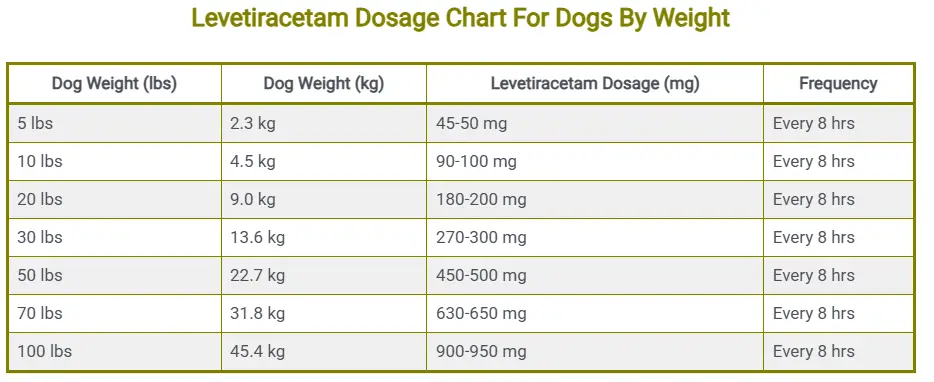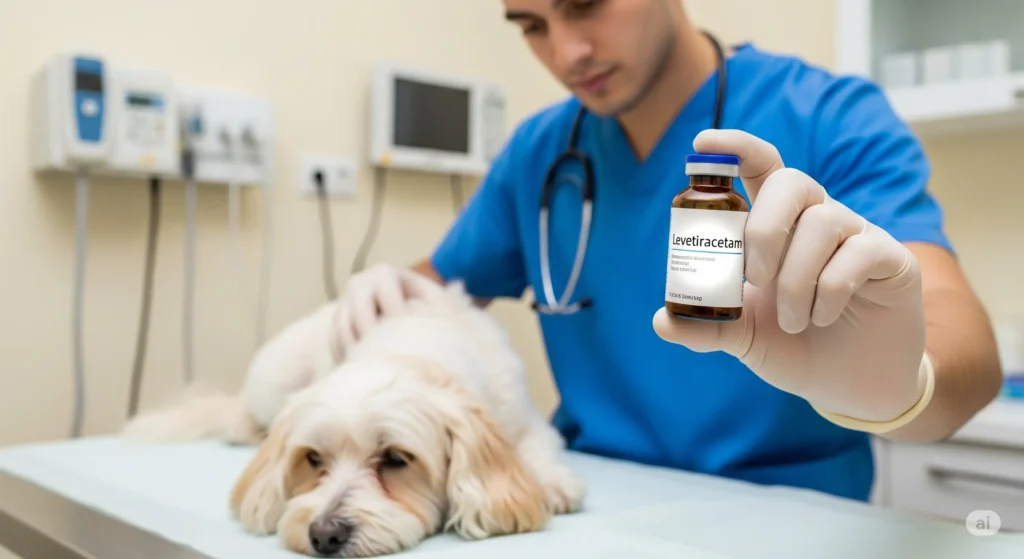Keppra® — known generically as levetiracetam for dogs— is a prescription anticonvulsant medication that’s gaining popularity in the veterinary world. It’s one of the few medications that effectively manage seizures in dogs while having fewer side effects compared to traditional anti-epileptic drugs. If your dog has been recently diagnosed with epilepsy or any seizure disorder, chances are your vet may mention Keppra® as a treatment option.
But before diving headfirst into medication, let’s get to know what Keppra® (Levetiracetam) really is. Originally developed for humans, levetiracetam has shown promising results in managing canine seizures due to its safe profile and effectiveness. Unlike older drugs like phenobarbital or potassium bromide, Keppra® doesn’t require liver metabolism, which makes it a safer option for dogs with liver issues.
Why is it used in dogs? Simply put: because it works. It helps manage seizures without many of the scary side effects, and it acts fast — often within 1-2 hours after administration. It’s also safe to be used alongside other medications, which is ideal for pets that need a multi-pronged approach to seizure management.
Disclaimer
Remember, never self-diagnose or self-dose. Seizure disorders are complex, and treatment plans must be tailored to each individual dog’s needs. But with patience, persistence, and veterinary support, a stable, seizure-managed life is possible.
Levetiracetam Dosage For Dogs
The general starting dose for levetiracetam in dogs is 20 mg/kg, given every 8 hours (three times a day). For example, if your dog weighs 10 kg (about 22 pounds), the dose would be roughly 200 mg, three times daily.
If you’re using the tablet form, which commonly comes in 250 mg or 500 mg sizes, must not be crushed, broken, or split (especially extended-release).
Dogs with kidney issues may need lower doses, while those with severe epilepsy might need more frequent dosing or a combination with other meds. Your vet might also suggest extended-release Keppra®, which is given twice daily instead of three times, but it should never be split or crushed.
Another key consideration: consistency. Give the medication at the same time every day to maintain even levels in your dog’s system. Missing doses or irregular timing can lead to breakthrough seizures.
Levetiracetam Dosage Chart For Dogs By Weight
| Dog Weight (lbs) | Dog Weight (kg) | Levetiracetam Dosage (mg) | Frequency |
|---|---|---|---|
| 5 lbs | 2.3 kg | 45-50 mg | Every 8 hrs |
| 10 lbs | 4.5 kg | 90-100 mg | Every 8 hrs |
| 20 lbs | 9.0 kg | 180-200 mg | Every 8 hrs |
| 30 lbs | 13.6 kg | 270-300 mg | Every 8 hrs |
| 50 lbs | 22.7 kg | 450-500 mg | Every 8 hrs |
| 70 lbs | 31.8 kg | 630-650 mg | Every 8 hrs |
| 100 lbs | 45.4 kg | 900-950 mg | Every 8 hrs |
Keppra® 250mg-500mg Dosage Chart For Dogs By Weight
| Dog Weight (lbs) | Dog Weight (kg) | Ideal Dose (mg @ 20mg/kg) | Closest Whole Tablet (250mg) | Closest Whole Tablet (500mg) |
|---|---|---|---|---|
| 11–15 lbs | 5–7 kg | 100–140 mg | 1 x 250mg | — |
| 16–25 lbs | 7.3–11.3 kg | 150–225 mg | 1 x 250mg | — |
| 26–35 lbs | 11.8–15.9 kg | 240–320 mg | 1 x 250mg | 1 x 500mg |
| 36–45 lbs | 16.3–20.4 kg | 325–410 mg | 2 x 250mg | 1 x 500mg |
| 46–55 lbs | 20.9–25 kg | 420–500 mg | 2 x 250mg | 1 x 500mg |
| 56–70 lbs | 25.4–31.8 kg | 510–640 mg | 3 x 250mg | 1 x 500mg |
| 71–90 lbs | 32.2–40.8 kg | 645–820 mg | 3 x 250mg | 2 x 500mg |
| 91–110 lbs | 41.3–50 kg | 825–1000 mg | 4 x 250mg | 2 x 500mg |
| 111–130 lbs | 50.4–59 kg | 1000–1180 mg | 5 x 250mg | 2 x 500mg + 1 x 250mg |
| 131–150 lbs | 59.4–68 kg | 1190–1360 mg | 5 x 250mg + 1 x 250mg | 3 x 500mg |
How Levetiracetam Works in Canine Bodies
Let’s simplify this — Levetiracetam works by calming down overactive neurons in the brain. Dogs with epilepsy or seizure disorders typically have brains that misfire — signals go haywire, leading to tremors, twitching, or full-blown seizures.
Levetiracetam binds to a protein in the brain called SV2A, which is thought to regulate neurotransmitter release. This binding stabilizes brain activity and reduces the likelihood of a seizure happening.
Now, compare that with older anti-epileptic drugs like phenobarbital, which suppress brain activity more generally and often come with heavy sedative effects.
Keppra® is different. It targets the problem more precisely, which means fewer side effects like lethargy or grogginess. And here’s the kicker: it doesn’t rely on the liver to do its job. So if your pup has liver concerns, Keppra® is a much safer bet.
Some dogs respond better to Keppra® than others. Breed, age, and seizure history play a big role. And while Keppra® (Levetiracetam) doesn’t “cure” seizures, it does reduce the frequency and severity significantly when used correctly.
Benefits of Keppra® for Dogs
The most obvious benefit? Fewer seizures. That alone is reason enough for many pet parents to embrace Keppra® with open arms. But the advantages go even deeper.
Keppra® helps stabilize the brain, so canines often show improved behavior and reduced anxiety. Dogs with chronic seizures can develop fear-based reactions or even aggression due to neurological instability. By minimizing the electrical chaos in their brains, Keppra® allows dogs to feel more secure and balanced.
Another big win: minimal side effects. Traditional seizure meds often make dogs lethargic, hungry, thirsty, and sometimes downright loopy. Keppra® typically doesn’t do that. Some dogs might be a little tired at first, but most bounce back quickly.
Keppra® is also safe for long-term use. And since it’s non-sedating and doesn’t impact the liver, your dog can stay on it for years with the right vet monitoring.
Plus, if your dog is already on another seizure medication, Keppra® can be added in without causing dangerous interactions. That makes it a great “team player” in the anti-seizure arsenal.
How to Administer Keppra® to Your Dog
Administering medication to a dog can be an exercise in creativity, patience, and persistence. Keppra® is available in both tablet and liquid forms, which gives dog owners some flexibility depending on their dog’s temperament, size, and eating habits.
Let’s talk tablets first. Most dog owners hide Keppra® tablets in food or treats. You can tuck the pill inside a piece of cheese, meatball, or a commercial pill pocket. Just be sure your dog eats the entire treat — some clever canines eat around the pill and spit it out like a seasoned magician.
Crushing the tablet is generally not recommended, especially if you’re using the extended-release version, as that can interfere with how the medication is absorbed.
Liquid levetiracetam can be a godsend for small puppies or picky eaters. You’ll administer it using a syringe (without a needle) directly into your dog’s mouth. It’s fast and accurate, though some dogs may resist the taste at first. You can ask your vet if a flavored version is available — some pharmacies even offer chicken- or beef-flavored compounds.
To make administration smoother:
- Keep a consistent schedule. Dogs thrive on routine.
- Reward your dog afterward. Praise and a small treat can turn medicine time into bonding time.
- Stay calm and confident. Dogs can pick up on your anxiety, which may make them more resistant.
If your furry friend vomits shortly after taking Keppra®, don’t give another dose without checking with your vet. Repeated missed doses or refusal to take the meds can lead to breakthrough seizures, which can be dangerous.
Side Effects and Risk Factors
Keppra® is often chosen specifically because it has fewer side effects than other anti-seizure drugs. That said, no medication is without risks, and some dogs do experience side effects — especially when starting a new dosage or switching from another drug.
The most common side effects include:
- Mild sedation or drowsiness
- Incoordination (acting wobbly or drunk)
- Drooling
- Vomiting or GI upset
- Hyperactivity or restlessness (less common)
These side effects often appear during the first few days or weeks of treatment and may subside as your dog adjusts to the medication. If they continue or worsen, your vet may recommend changing the dosage or switching medications.
Rare but serious side effects can include:
- Severe lethargy or confusion
- Allergic reactions (swelling, hives, difficulty breathing)
- Changes in behavior (aggression, depression)
- Liver enzyme abnormalities (though rare with Keppra®)
If you see any sudden or alarming changes in your dog’s behavior, appetite, or physical condition, call your veterinarian immediately. Don’t try to self-adjust the dosage or stop the medication without professional advice, as that can trigger rebound seizures — sometimes worse than the original condition.
Also, if your dog has kidney disease, Keppra® should be used with caution. The drug is primarily excreted by the kidneys, so dogs with impaired kidney function may need a lower dose or extended dosing intervals to avoid drug buildup.
Interactions with Other Medications
Here’s where things can get a bit tricky — especially if your dog is on multiple medications. Keppra® is often used in combination with other anti-epileptic drugs like phenobarbital or zonisamide. The good news is, it typically doesn’t interfere with these medications and has a relatively clean interaction profile.
However, some medications can impact how Keppra® works or vice versa:
- Phenobarbital may reduce Keppra® levels in the bloodstream, requiring a higher dose of Keppra®.
- NSAIDs (like Rimadyl or Metacam) can stress the kidneys, potentially complicating Keppra® elimination.
- Other sedatives or behavior meds can increase drowsiness when used with Keppra®.
To avoid interactions:
- Always tell your vet about every supplement, herbal remedy, or drug your dog is taking.
- Never start a new medication without checking if it’s compatible with Keppra®.
- Monitor your dog closely after any medication changes and report anything unusual.
If your vet suspects a drug interaction, they may run blood tests or tweak the dosing to get everything balanced just right. It’s all about teamwork between you and your vet.
Monitoring and Adjusting the Dosage
Monitoring your dog’s response to Keppra® isn’t a one-time task—it’s an ongoing process that ensures the medication is doing its job effectively without causing unwanted side effects. Every dog reacts differently, so finding the “sweet spot” in terms of dosage may take a little time and observation.
In the early stages of treatment, you’ll want to keep a seizure diary. This can be as simple as jotting down:
- The date and time of each seizure
- The duration and severity
- Any potential triggers (like stress, diet changes, etc.)
- Behavioral changes post-seizure
This helps your vet determine whether the current dose is effective. If seizures become less frequent or less intense, that’s a sign the medication is working. On the flip side, if seizures persist or worsen, a dosage adjustment may be necessary.
Your vet might also suggest bloodwork—not because Keppra® requires it for monitoring drug levels (it usually doesn’t), but to keep an eye on your dog’s general health and kidney function over time. If your dog is on multiple medications, this becomes even more crucial.
Some dogs will need dosage tweaks due to:
- Growth (especially in puppies)
- Weight gain or loss
- Development of kidney issues
- Increased seizure frequency
- Side effects or drug interactions
Never adjust the dosage on your own. It may seem harmless to increase or skip a dose, but even small changes can lead to breakthrough seizures or side effects. Always follow your vet’s guidance and discuss any concerns before making changes.
You May Also Like To Read:
Emergency Situations and Overdose Protocol
Let’s talk worst-case scenarios—because preparation is everything when you’re managing a chronic condition like canine epilepsy.
A Keppra® overdose isn’t usually fatal, but it can be dangerous, especially in small dogs or those with underlying health conditions. An overdose typically happens when a dog accidentally gets into the medication bottle or when a well-meaning owner miscalculates the dose.
Signs of overdose include:
- Extreme drowsiness or sedation
- Unsteady movements (ataxia)
- Vomiting or diarrhea
- Tremors or twitching
- Labored breathing
If you suspect your dog has ingested too much Keppra®, don’t wait. Call your vet or an emergency animal poison control line (ASPCA Poison Control or Pet Poison Helpline) immediately.
You may be advised to induce vomiting (if it’s within 30 minutes of ingestion) or rush your dog to the nearest emergency clinic.
In emergency settings, treatment may involve:
- IV fluids to flush out the drug
- Activated charcoal to reduce absorption
- Medications to stabilize heart rate and respiration
- Monitoring for secondary complications like aspiration or kidney stress
But what about seizure emergencies? If your dog has a cluster of seizures or a seizure that lasts longer than 5 minutes (status epilepticus), it’s a life-threatening emergency. Have a seizure emergency plan in place:
- Know the nearest 24/7 emergency vet clinic
- Have emergency meds like rectal diazepam (if prescribed)
- Keep a written protocol for what to do in case of status seizures
Emergency preparedness could be the difference between life and death. It’s scary, but the more you plan ahead, the more in control you’ll feel when seconds count.
Special Considerations for Puppies and Senior Dogs
Age is more than just a number when it comes to medication. Puppies and senior dogs both require special attention when prescribing and administering Keppra® due to their unique metabolic and physiological conditions.
Puppies have developing organs, which means their liver and kidneys may not process drugs the same way adult dogs do. While Keppra® is relatively safe, doses must be carefully calculated by weight, and adjustments may be frequent as your puppy grows. Puppies also have faster metabolisms, which can affect how quickly they process the medication. This sometimes means shorter intervals between doses.
Signs to watch for in puppies include:
- Increased sedation or hyperactivity
- Difficulty walking or coordination problems
- Poor appetite or gastrointestinal upset
If your puppy is on Keppra®, regular weigh-ins and vet visits are a must. Dosing needs can change fast, and it’s important to keep everything up-to-date.
Senior dogs, on the other hand, often have reduced kidney function—even if it hasn’t been diagnosed formally. Because Keppra® is cleared through the kidneys, it can accumulate in the body if the kidneys aren’t working well. This can lead to toxicity or increased side effects.
Older dogs may also be on multiple medications for arthritis, heart disease, or diabetes, which increases the risk of drug interactions. Your vet may recommend lower doses, slower titration, or more frequent monitoring to keep things safe.
Whether you have a playful pup or a dignified elder dog, it’s all about balance. With careful monitoring and individualized dosing, Keppra® can help dogs of all ages lead seizure-free, high-quality lives.
Cost and Availability
Keppra® can be a bit on the pricey side—especially if your dog is large or requires extended-release tablets. The cost varies depending on the form (brand-name vs. generic), dosage, and whether you’re buying from a vet clinic, local pharmacy, or an online pet pharmacy.
Here’s a general breakdown:
- Immediate-release generic levetiracetam tablets: Usually the most affordable. A month’s supply can range from $15–$40 for small dogs, and $50–$150+ for larger breeds.
- Extended-release tablets: More expensive. These can cost $1–$3 per tablet, so monthly expenses might range from $60 to $180 or more.
- Liquid form (compounded): Costs vary widely but may be higher than tablets due to compounding fees. Expect $30–$80 per bottle depending on concentration and size.
Tips to save money:
- Ask your vet if human generics are suitable
- Compare prices at Chewy, 1-800-PetMeds, or Costco Pharmacy
- See if your vet offers bulk discounts
Make sure to only buy from trusted sources. Counterfeit or improperly stored medications can harm your pet. Stick to licensed veterinary pharmacies or well-known retail chains.
Veterinary Advice and Regular Checkups
While Keppra® is considered a relatively safe and effective medication for dogs, it’s not a “set-it-and-forget-it” solution. Managing epilepsy—or any seizure disorder—requires ongoing collaboration between pet owners and veterinarians. Regular checkups are absolutely essential to ensure that your dog stays healthy and seizure-free over the long haul.
After starting Keppra®, your vet will usually schedule a follow-up within the first 2–4 weeks. This is a critical period when your dog’s body is adjusting to the medication. The vet will check for:
- Efficacy (Are the seizures less frequent or severe?)
- Side effects (Has your dog become overly sedated or hyperactive?)
- Tolerance (Is the dose too strong or too weak?)
- Any new symptoms that might suggest an issue
Blood tests might be recommended to evaluate kidney function, especially if your dog is on Keppra® long term or has other health issues. While Keppra® doesn’t require therapeutic blood level monitoring like phenobarbital does, monitoring the general health of your dog is key to preventing long-term complications.
It’s also important to keep your vet in the loop if anything changes:
- A new seizure pattern
- Changes in weight
- Additional medications
- Vomiting after pills
- Behavioral shifts
Even a small change in routine can affect how your dog processes their medication. That’s why open communication with your vet is essential. Don’t hesitate to ask questions or raise concerns—your vet is your partner in making sure your dog gets the best care possible.
Final Thoughts
Managing seizures in dogs is no easy task, but levetiracetam offers a reliable, safe, and flexible treatment option for many pet owners. From its fast action and minimal side effects to its compatibility with other drugs, Keppra® stands out as a top-tier anticonvulsant—especially when liver safety is a concern.
By working closely with your veterinarian, following precise dosage guidelines, and monitoring your dog’s response over time, you can dramatically improve your pup’s quality of life. Whether your dog is young, old, small, or large, there’s a safe and effective way to manage seizures—and Keppra® might just be the key.
FAQs
Can dogs take Keppra® for life?
Yes. Many dogs are maintained on Keppra® long term, sometimes for life. With proper veterinary supervision and regular monitoring, dogs can thrive on this medication without serious complications.
Is it safe to give Keppra® with food?
Absolutely. In fact, giving it with food can reduce the risk of stomach upset. It also helps dogs associate the medication with something pleasant.
Can I stop Keppra® suddenly if seizures go away?
No. Stopping Keppra® abruptly can cause rebound seizures, which may be more severe or dangerous. Always consult your vet before making any changes to medication.
What should I do if I miss a dose?
Give the missed dose as soon as you remember. If it’s close to the next scheduled dose, skip the missed one and continue as usual. Do not double the dose unless advised by your vet.
How should I store Keppra®?
Store in a cool, dry place at room temperature. Keep the medication in its original container, out of reach of children and pets. Avoid exposure to moisture or sunlight.
Is Keppra® better than phenobarbital for dogs?
Keppra® is considered safer in some cases, especially for dogs with liver issues. However, phenobarbital may be more effective for severe seizures. Vets sometimes prescribe both together.
Can Keppra® be used for cluster seizures?
Yes, and it often is. In some cases, vets may increase the dose during clusters or combine Keppra® with other emergency meds like diazepam.
How fast does Keppra® start working in dogs?
It usually starts working within 1–2 hours of administration. That makes it a great option for quick seizure control.
Can I give my dog over-the-counter human levetiracetam?
Only with veterinary approval. The dosage must be calculated precisely based on your dog’s weight and condition.
Is it safe to combine Keppra® with CBD oil or natural supplements?
Sometimes, but always check with your vet. Natural doesn’t mean safe—some supplements can interact with seizure meds.












![Can Dogs Eat Blood? 7 Side Effects [Expert Opinion]](https://petskor.com/wp-content/uploads/2022/04/Webp.net-resizeimage-12.jpg)
